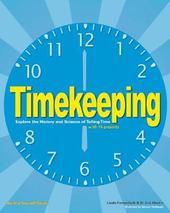
|
Timekeeping: Explore the History and Science of Telling Time
Paperback / softback
Main Details
| Title |
Timekeeping: Explore the History and Science of Telling Time
|
| Authors and Contributors |
By (author) Linda Formichelli
|
|
By (author) Maxine Anderson
|
|
Illustrated by Samuel Carbaugh
|
| Physical Properties |
| Format:Paperback / softback | | Pages:128 | | Dimensions(mm): Height 254,Width 204 |
|
| Category/Genre | Reference |
|---|
| ISBN/Barcode |
9781619300330
|
| Classifications | Dewey:529 |
|---|
| Audience | |
|---|
| Illustrations |
illustrations
|
|
Publishing Details |
| Publisher |
Nomad Press
|
| Imprint |
Nomad Press
|
| Publication Date |
25 October 2012 |
| Publication Country |
United States
|
Description
Timekeeping: Explore the History and Science of Telling Time travels through the past and into the future to explore how humans have measured the passage of time. From ancient civilization's earliest calendars and shadow clocks to GPS and the atomic clocks of today, kids will track the evolution of timekeeping devices, meet the inventors of calendars and clocks, and learn interesting facts and trivia. Hands-on projects and activities include making a shadow clock, using a protractor to create a sundial, measuring time using water, and creating your own calendar. Kids will understand how civilization's vague abilities to track days and months has transformed over the centuries into a sophisticated ability to keep time to the millionth of a second.
Author Biography
Linda Formichelli is a freelance writer whose articles have appeared in several youth and science publications including Ack!, Delta Education, Odyssey, Yes, and Zillions. She is the author of Becoming a Personal Trainer for Dummies, Renegade Writer, and a coauthor of Tools of Timekeeping. W. Eric Martin has written articles for more than 50 publications and has provided dictionary entries for Thomson Gale's World of Computer Science. He is a coauthor of Tools of Timekeeping. They both live in Blackstone, Massachusetts. Sam Carbaugh is the illustrator of Amazing Math Projects You Can Build Yourself, Discover the Desert, Food: 25 Amazing Projects, George Washington: 25 Great Projects You Can Build Yourself, and Robotics." He lives in Grand Rapids, Michigan.
ReviewsVOYA "...With a friendly, relaxed writing style, Formichelli and Martin cover the history of timekeeping beginning with the first humans, who measured time simply by watching the seasons, and ending with the invention of astoundingly precise atomic and optical clocks. The book covers the development of the first calendars, interesting clocks throughout the ages, the world's time zones, and daylight savings time. Intriguing science experiments demonstrate various concepts of time and give the reader instructions to build several timekeeping mechanisms. The authors also include a timeline of major developments in the science of timekeeping and provide lists of websites and famous monuments involving time. To be able to address a topic as complex as that of time in such a concise and interesting manner is truly impressive... this book is generally readable, enjoyable, and extremely informative." Booklist "...Fifteen versatile and hands-on projects range from very simple exercises that can be completed in moments, such as reading seasons from a shadow, to more sophisticated temporal experiments like making your own incense clock. These projects could be used as a fun diversion on a rainy afternoon at home or as the crux of an elementary science lesson." Dave White, Publisher, Social Studies for Kids "Timekeeping: Explore the History and Science of Telling Time is well worth a read--or two or three. The fun illustrations complement the informative text, taking readers on a tour de force of time and timekeeping through the ages. With its combination of solid concepts and fun activities, this book will be a popular addition to the bookshelves of many a student, parent, or teacher." Marla Conn,Educational Consultant "Timekeeping does a fantastic job of teaching the history of time from prehistoric days using simple sundials to present day GPS technology. The content meets the Common Core State Standards in math, science, social studies, and technology, while the activities provide interactive hands-on learning experiences that make learning fun and meaningful!"
|